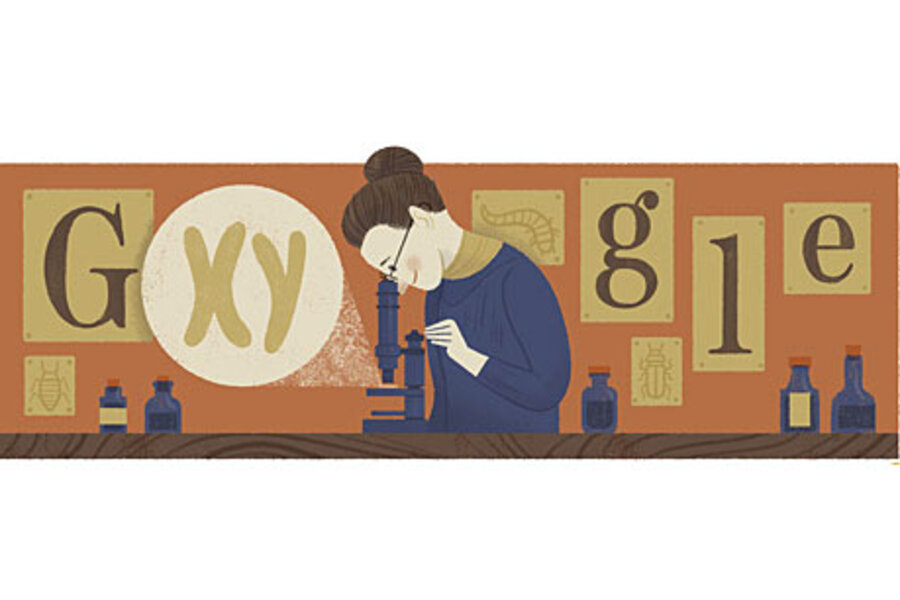Nettie Stevens, biology pioneer: A role model for female scientists?
Loading...
The female scientist who discovered the role of X and Y chromosomes in determining sex is honored with a Google Doodle on Thursday, her 155th birthday.
Nettie Stevens was the first to identify the solely genetic cause of biological sex, which she discovered while doing doctoral research with mealworm beetles at Bryn Mawr College in Pennsylvania. Her early death – and her own pair of X chromosomes, perhaps – led her work to be overshadowed by Edmund Beecher Wilson, who made a similar discovery around the same time.
A Google Doodle celebrates her discovery and her contributions not only to scientific knowledge, but as a trail-blazer in her field. Within the sciences, biology currently holds the record for female researchers, as women still struggle to receive tenure and stay in academia relative to their male colleagues in most fields.
While studies with children show girls and boys are equally likely to excel in science and math, young men are three times more likely to become science researchers. Biology remains a remarkable exception to this trend, as female biologists received 52 percent of doctorate degrees awarded in 2009, the second year in a row that women took the majority of these degrees.
By contrast, less than one-third of doctorate degrees in the physical sciences, statistics, or math went to women.
Even in biology, fewer women prevail among collegiate faculty, as only 36 percent of assistant professors and 18 percent of full professors nationwide are women. This may stem from a scarcity of female grad students hired by the nation's elite labs, which are run by winners of prestigious awards such as the Nobel Prize and the National Medal of Science and serve as useful bases for climbing the career ladder into academia, according to a study by MIT.
"Once you know what the problem is, you can actually do something about it. It's a great opportunity for these highly accomplished scientists to really reach out and make a very conscious effort to do something about the gender landscape of science at high-powered research institutions," Angelika Amon, the Kathleen and Curtis Marble Professor in Cancer Research in MIT's Department of Biology, said of the study. "A large segment of the population is being excluded from doing high-level research, and that can never be a good thing. We're losing out on bright and intelligent people."
Other areas of the biology workforce have held more promise for women. In healthcare and other biology-related fields, women achieve more proportionate employment, Lydia Dishman reported for Fast Company. Some 80 percent of healthcare providers are women, and women represent 46 percent of researchers in other fields of biology.
Fields where women have found success can offer lessons to members of other STEM fields who want to boost the share of women in the ranks, as female leadership and collaborative work environments have proved helpful to women moving into STEM.
Finding a mentor proved essential for Kay Havens, the Medard and Elizabeth Welch director of plant science and conservation at the Chicago Botanic Garden, who received her doctorate in biology from Indiana University, Bloomington.
"Without strong mentorship, it can be difficult for anyone to navigate any career, but particularly one in the sciences, which are often dominated by men," Dr. Havens told Fast Company.
Havens teamed up with her mentor to start the Conservation Land Management fellowship, which provides budding botanists with placement in the Bureau of Land Management, the National Park Service, the US Forest Service, and the US Fish and Wildlife Service, mentoring, and female leadership.
"Mixing the opportunity, exposure to nature, and mentorship is key to a career in biological science," Havens told Fast Company.
Dr. Stevens mentored many younger scientists. According to her Bryn Mawr obituary, she once told a student, "How could you think your questions would bother me? They never will, so long as I keep my enthusiasm for biology; and that, I hope will be as long as I live."






